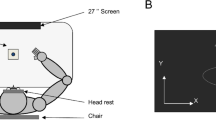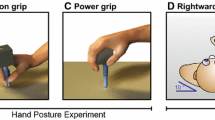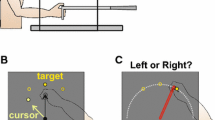Abstract
We previously reported that opposite arm training improved the initial direction of dominant arm movements, whereas it only improved the final position accuracy of non-dominant arm movements. We now ask whether each controller accesses common, or separate, short-term memory resources. To address this question, we investigated interlimb transfer of learning for visuomotor rotations that were directed oppositely [clockwise (CW)/counterclockwise (CCW)] for the two arms. We expected that if information obtained by initial training was stored in the same short-term memory space for both arms, opposite arm training of a CW rotation would interfere with subsequent adaptation to a CCW rotation. All subjects first adapted to a 30° rotation (CW) in the visual display during reaching movements. Following this, they adapted to a 30° rotation in the opposite direction (CCW) with the other arm. In contrast to our previous findings for interlimb transfer of same direction rotations (CCW/CCW), no effects of opposite arm adaptation were indicated in the initial trials performed. This indicates that interlimb transfer is not obligatory, and suggests that short-term memory resources for the two limbs are independent. Through single trial analysis, we found that the direction and final position errors of the first trial of movement, following opposite arm training, were always the same as those of naive performance. This was true whether the opposite arm was trained with the same or the opposing rotation. When trained with the same rotation, transfer of learning did not occur until the second trial. These findings suggest that the selective use of opposite arm information is dependent on the first trial to probe current movement conditions. Interestingly, the final extent of adaptation appeared to be reduced by opposite arm training of opposing rotations. Thus, the extent of adaptation, but not initial information transfer, appears obligatorily affected by prior opposite arm adaptation. According to our findings, it is plausible that the initiation and the final extent of adaptation involve two independent neural processes. Theoretical implications of these findings are discussed.


Similar content being viewed by others
References
Criscimagna-Hemminger SE, Donchin O, Gazzaniga MS, Shadmehr R (2003) Learned dynamics of reaching movements generalize from dominant to nondominant arm. J Neurophysiol 89:168–176
Dizio P, Lackner JR (1995) Motor adaptation to Coriolis force perturbations of reaching movements: endpoint but not trajectory adaptation transfers to the nonexposed arm. J Neurophysiol 74:1787–1792
Elliott D, Roy EA (1981) Interlimb transfer after adaptation to visual displacement: patterns predicted from the functional closeness of limb neural control centres. Perception 10:383–389
Gordon J, Ghilardi MF, Ghez C (1994) Accuracy of planar reaching movements. I. Independence of direction and extent variability. Exp Brain Res 99:97–111
Gottlieb GL (1996) Muscle compliance: implications for the control of movement. Exerc Sport Sci Rev 24:1–34
Hirayama M, Kawato M, Jordan MI (1993) The cascade neural network model and a speed-accuracy trade-off of arm movement. J Motor Behav 25:162–174
Imamizu H, Shimojo S (1995) The locus of visual-motor learning at the task or manipulator level: implications from intermanual transfer. J Exp Psychol Hum Percept Perform 21:719–733
Krakauer JW, Ghilardi MF, Ghez C (1999) Independent learning of internal models for kinematic and dynamic control of reaching. Nat Neurosci 2:1026–1031
Laszlo JI, Baguley RA, Bairstow PJ (1970) Bilateral transfer in tapping skill in the absence of peripheral information. J Motor Behav 2:261–271
Logan GD (1988) Toward an instance theory of automatization. Psychol Rev 95:492–527
Marzi CA, Bisiacchi P, Nicoletti R (1991) Is interhemispheric transfer of visuomotor information asymmetric? Evidence from a meta-analysis. Neuropsychologia 29:1163–1177
Morton SM, Lang CE, Bastian AJ (2001) Inter- and intra-limb generalization of adaptation during catching. Exp Brain Res 141:438–445
Oldfield RC (1971) The assessment and analysis of handedness: the Edinburgh Inventory. Neuropsychologia 9:97–113
Parlow SE, Kinsbourne M (1989) Asymmetrical transfer of training between hands: implications for interhemispheric communication in normal brain. Brain Cogn 11:98–113
Sainburg RL (2002) Evidence for a dynamic-dominance hypothesis of handedness. Exp Brain Res 142:241–258
Sainburg RL, Kalakanis D (2000) Differences in control of limb dynamics during dominant and nondominant arm reaching. J Neurophysiol 83:2661–2675
Sainburg R, Wang J (2002) Interlimb transfer of visuomotor rotations: independence of direction and final position information. Exp Brain Res 145:437–447
Shadmehr R, Brashers-Krug T (1997) Functional stages in the formation of human long-term motor memory. J Neurosci 17:409–419
Shadmehr R, Holcomb HH (1997) Neural correlates of motor memory consolidation. Science 277:821–825
Stoddard J, Vaid J (1996) Asymmetries in intermanual transfer of maze learning in right- and left-handed adults. Neuropsychologia 34:605–608
Taylor HG, Heilman KM (1980) Left-hemisphere motor dominance in righthanders. Cortex 16:587–603
Thut G, Cook ND, Regard M, Leenders KL, Halsband U, Landis T (1996) Intermanual transfer of proximal and distal motor engrams in humans. Exp Brain Res 108:321–327
Tong C, Wolpert DM, Flanagan JR (2002) Kinematics and dynamics are not represented independently in motor working memory: evidence from an interference study. J Neurosci 22:1108–1113
Wigmore V, Tong C, Flanagan JR (2002) Visuomotor rotations of varying size and direction compete for a single internal model in motor working memory. J Exp Psychol Hum Percept Perform 28:447–457
Author information
Authors and Affiliations
Corresponding author
Additional information
This research was supported by National Institutes of Health grant # R01HD39311
Rights and permissions
About this article
Cite this article
Wang, J., Sainburg, R.L. Mechanisms underlying interlimb transfer of visuomotor rotations. Exp Brain Res 149, 520–526 (2003). https://doi.org/10.1007/s00221-003-1392-x
Received:
Accepted:
Published:
Issue Date:
DOI: https://doi.org/10.1007/s00221-003-1392-x




